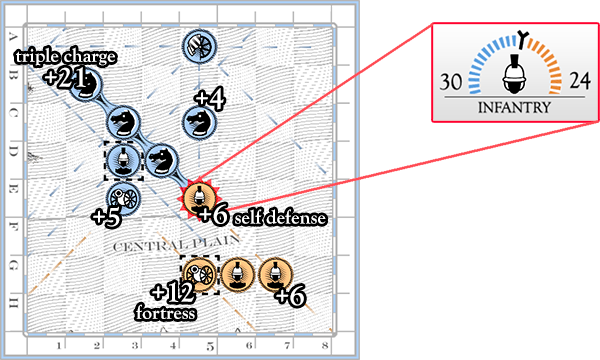The game proceeds in turns. A player may move up to five units each turn, followed by a single attack against an enemy unit. Moving fewer than five units is allowed, and the attack is not obligatory. Movement range varies per unit type. No single unit can move more than once per turn.
Move Marker
Unit has already moved this turn.
Unit has already moved this turn.
Online Square
Indicates a square that is online within a unit's range of movement.
Indicates a square that is online within a unit's range of movement.
Offline Square
Indicates a square that is offline within a unit's range of movement.
Indicates a square that is offline within a unit's range of movement.
Attack
An attack is determined by summing all the offensive power in range of an enemy target square, then comparing this number to a summation of all the defensive power supporting the same target square. Offensive and defensive power emanates from a unit in a straight line, either vertically, horizontally, or at 45º diagonals.
An inspection of the southern infantry at E5 will help explain how combat works in the game. First determine whose turn it is, since this will identify which side is on offense versus defense. It's north's turn in this example, thus north is on offense and south is on defense.
The southern infantry at E5 is defended by summing all friendly pieces in range. It defends itself for 6 points, and receives help from two other pieces for a total of 24.
As for attack, the northern cavalry charge aims 21 attack points against E5. Two other units also add attack power, totaling 30 cumulative points for north.
Since 30 is greater than 24, the south's infantry is vulnerable to capture by north.
Note that the units at D3 and G6 do not contribute any attack or defense because they are not in a direct line (horizontal, vertical, or 45º diagonal) with the infantry at E5.

North's Combat Score
If north is on offense, the blue dial will represent north's attack score; on defense, its defensive score.
If north is on offense, the blue dial will represent north's attack score; on defense, its defensive score.

South's Combat Score
If south is on offense, the orange dial will represent south's attack score; on defense, its defensive score.
If south is on offense, the orange dial will represent south's attack score; on defense, its defensive score.
Capture vs. Forced Retreat
If the offensive power is less than or equal to the defensive power, the unit is secure. If the offensive power is two or more, the unit is capturable. If the offensive power is 1 point greater, the vulnerable unit resists but can be put into a forced retreat. With a forced retreat, the defender is obligated to move the unit at the commencement of its next turn. The retreating piece is also excluded from offensive combat in that turn. If there is no open square available for retreat, the unit is automatically captured.
Capture
Unit is vulnerable to capture.
Unit is vulnerable to capture.

Forced Retreat
Unit is vulnerable to a forced retreat.
Unit is vulnerable to a forced retreat.

